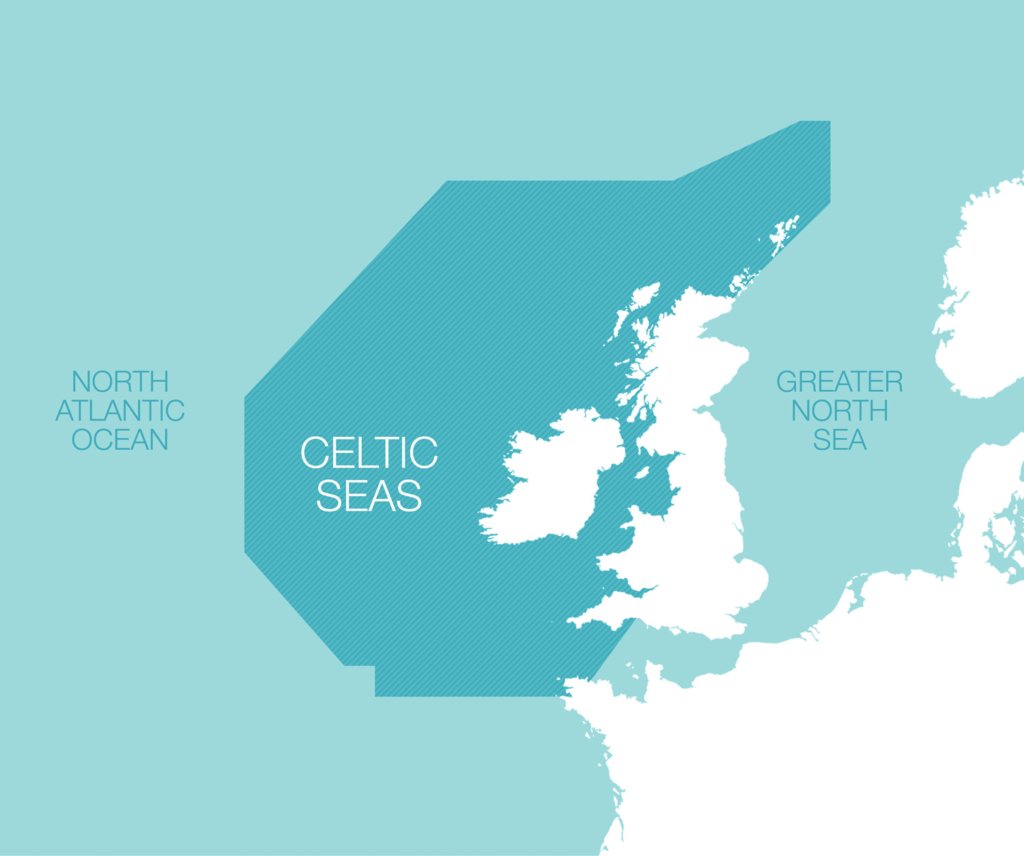The Celtic Sea is the area of the Atlantic Ocean off the southern coast of Ireland bounded to the east by Saint George’s Channel; other limits include the Bristol Channel, the English Channel, and the Bay of Biscay, as well as adjacent portions of Wales, Cornwall, and Brittany. The southern and western boundaries are delimited by the continental shelf, which drops away sharply. The Isles of Scilly are an archipelago of small islands in the sea.
The Celtic Sea receives its name from the Celtic heritage of the bounding lands to the north and east. The Celtic Sea is a shallow embayment of the eastern North Atlantic bounded by the Celtic lands of Southern Ireland, south–west Wales, Cornwall, and Brittany. The warmest water in Celtic Sea was recorded today in Daoulas. The water temperature in this location is 50°F. And the coldest in Arnside, its value 42°F.
There are no land features to divide the Celtic Sea from the open Atlantic Ocean to the south and west. For these limits, Holt suggested the 200-fathom (370 m; 1,200 ft) marine contour and the island of Ushant off the tip of Brittany.
The definition approved by 1974 by the UK Hydrographer of the Navy for use in Admiralty Charts was “bounded roughly by lines joining Ushant, Land’s End, Hartland Point, Lundy Island, St. Govan’s Head and Rosslare, thence following the Irish coast south to Mizen Head and then along the 200-metre isobath to approximately the latitude of Ushant.”
The International Hydrographic Organization defines the limits of the Celtic Sea as follows:
On the North. The Southern limit of the Irish Sea [a line joining St David’s Head to Carnsore Point], the South coast of Ireland, thence from Mizen Head a line drawn to a position 51°0′N 11°30′W.
On the West and South. A line from the position 51°0′N 11°30′W South to 49°N, thence to latitude 46°30’N on the Western limit of the Bay of Biscay [a line joining Cape Ortegal to Penmarch Point], thence along that line to Penmarch Point.
On the East. The Western limit of the English Channel [a line joining Île Vierge to Land’s End] and the Western limit of the Bristol Channel [a line joining Hartland Point to St. Govan’s Head].
Is there oil in the Celtic Sea?
The Barryroe oil field lies in the North Celtic Sea Basin, offshore Ireland. Image courtesy of Providence Resources. Five wells have been drilled at the Barryroe field by various companies, which encountered oil in the Middle and Lower Wealden sequences.
How deep is the Celtic Deep? between 100 – 200 metres
The site forms a depression on the seafloor compared to the surrounding area with water depths of between 100 – 200 metres within the site.
The Irish Sea is also known as the Mann Sea, Manx Sea and Celtic Sea. Experts believe that a majority of Irish people have Celtic roots; however, a study published on Thursday found they may also have a great deal of influence from the Vikings, Anglo-Normans, and British.


Today, the term ‘Celtic’ generally refers to the languages and cultures of Ireland, Scotland, Wales, Cornwall, the Isle of Man, and Brittany; also called the Celtic nations. These are the regions where Celtic languages are still spoken to some extent.
Unlike the Vikings, the Celts had chariots and wood horsemen. With their tattoos and wood raids, one might claim that the Celts were more visually “rustic,” but the Vikings were more savage and barbaric, undoubtedly. The Celts were far more sophisticated than we sometimes give them credit for.
What countries are still Celtic?
In addition to Ireland, Wales, and Scotland, the other three Celtic nations are the Isle of Man, Cornwall (the southwest corner of England), and Brittany (the northwest region of France). Each of these nations has a strong Celtic identity and a distinct language that is spoken to this day.
What part of UK is Celtic?
In fact the Celtic parts of the UK (Scotland, Northern Ireland, Wales and Cornwall) are among the most different from each other genetically. For example, the Cornish are much more similar genetically to other English groups than they are to the Welsh or the Scots.
Is Celtic a religion?
The Celtic religion was closely tied to the natural world and they worshipped gods in sacred places like lakes, rivers, cliffs and bushes. The moon, the sun and the stars were especially important – the Celts thought that there were supernatural forces in every aspect of the natural world.
Is Celtic a race or culture?
The finding is the first genetic evidence to confirm what some archaeologists have long been arguing: that Celts represent a tradition or culture rather than a genetic or racial grouping.
